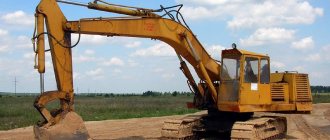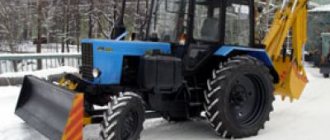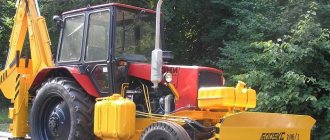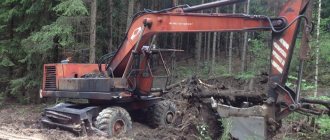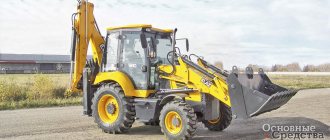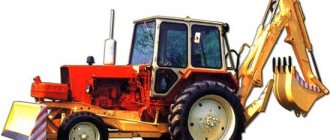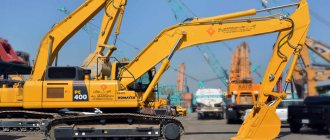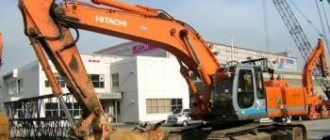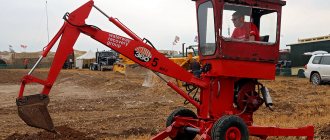The EO-4121 excavator became the very first full-rotary hydraulic crawler excavator in the Soviet Union, which was put into mass production. It belongs to the 4th size group and is designed to perform work with buckets with a capacity of 0.65 - 1.5 cubic meters. "EO-4121" is a typical crawler excavator for most construction sites in the USSR in the second half of the 70s - late 80s of the twentieth century. Serial production of this model and its modernized versions “EO-4121A” and “EO-4121B” was carried out at the Kovrov Excavator Plant from 1974 to 1991.
The purpose of the EO-4121 excavator is the widest range of earthworks: excavation, construction of pits and trenches, construction of new or cleaning of existing reclamation canals, loading of bulk materials and finely crushed rocks with pieces up to forty centimeters in diameter. "EO-4121" can carry out excavation work with soils of categories I-IV - from light loose sand to permafrost and heavy clay soils.
History of creation
The debut copy of this earth-moving equipment was assembled in 1970. After passing comprehensive tests, serial production of EO-4121 excavators was launched in 1974 at the Kovrov Excavator Plant, Vladimir Region.
Kovrovsky Excavator is the manufacturer of the first excavator in our country and, in general, one of the oldest enterprises in the entire domestic mechanical engineering industry. It was founded on the production base of railway workshops operating since 1861 at the Kovrov station of the Moscow-Nizhny Novgorod railway.
In 1930, the workshops were transformed into a plant for the repair of foreign-made earth-moving machines. And already on April 21, 1931, the first Soviet excavator in history was built here, which became the ancestor of the extensive family of Kovrovets excavators.
Both in Soviet times and to this day, the Kovrov Excavator Plant is one of the most advanced and leading domestic enterprises in this industry. Over the years of operation, about one hundred thousand units of earth-moving equipment rolled off its assembly line, and the number of different models and modifications reached 64 types. The EO-4121 excavator lasted on the factory assembly line until 1991, and its direct “descendants” were the EO-4124, EO-4125, EO-4224, MTP-71 (“EO-71”) models. 4221"). The modern embodiment of the EO-4121 concept can be called the EO-4225 excavator - a more progressive and advanced version.
Today Excavatorny specializes in the production of full-rotary hydraulic crawler excavators: “KiT-26”, “EO-4225A-071”, “EO-4225A-061” with a full range of attachments. It also produces forestry and loading equipment.
Purpose
The EO-4121 crawler excavator is designed to perform work such as digging trenches and pits of various depths; creation of embankments of soil and other bulk materials; cleaning work areas from industrial waste; loosening of solid soil masses; digging canals; well development; destruction of any concrete structures; loading and unloading various materials.
The equipment is capable of handling soil of the first, second, third and fourth density categories, however, the latter requires preliminary loosening, which the excavator can carry out either using a hydraulic breaker hammer or using single-tooth loosening equipment.
In Soviet times, this model was often used on construction sites, but sometimes the operation of this equipment was also observed in industrial sectors.
Video: Operation of the EO-5124 excavator
Purpose and scope of use of an excavator of the fifth size group weighing 39 tons with a tractor-type crawler drive and rigid suspension of the operating equipment. Effectively used:
- when preparing pits for foundations, digging trenches and ditches in soils up to density group IV;
- in moving bulk materials into piles and loading them into vehicles;
- when carrying out planning work;
- for demolition and dismantling of buildings and structures.
The basic scheme for installing the “backhoe” operating equipment; on dense soils, the bucket and boom-handle are switched to the “forward shovel” mode. As additional equipment, a universal-purpose hydraulic hammer, ripper tooth, hydraulic shears, grab loading devices, and drilling equipment are used.
Specifications
General parameters of the EO-4121 excavator:
- Wheel formula – 4 by 4;
- Length without bucket – 4.9 m, width – 2.9 m, height – 3.060 m;
- Track base – 2,750 m;
- The size of the caterpillar track is length 2.93 m, belt width 0.58 m;
- Platform revolutions per minute – 6;
- Platform width – 3 m;
- Ground clearance under the turntable – 942 mm;
- The height of the arrow heel axis is 2.02 m;
- The distance from the heel axis to the axis of rotation is 520 mm;
- Weight with a front shovel - 19.87 tons, with a backhoe - 20.9 tons, with a grab - 20.9 tons, with a loader - 19.87 tons;
- Travel speed – 2.8 km/hour.
- The surmountable slope of the path is 22 degrees;
- Productivity – up to 150 cubic meters per hour.
Characteristics of the working bucket model:
- Capacity – from 0.65 to 1.5 cubic meters;
- Digging radius – 9.2 m (backhoe); 7.25 m (straight shovel); 8.9 (grab); 3.75 m (by loader);
- The radius described by the tail part of the platform is 3.13 m;
- Digging depth – 5.8 m (backhoe); 3.6 m (straight shovel); 3.2 m (grab);
- Loading height – 5 meters;
- The force on the bucket teeth is 14,200 kgf;
- Cycle time – with straight shovel and loader: 16 seconds; with backhoe: 20 seconds.
Depending on the type of bucket used, these data may vary slightly. The specific ground pressure indicator for EO-4121 brand excavators is 63.6 kPa, the minimum cycle duration at a 90-degree rotation angle is 18 seconds.
Engine
The EO-4121 excavators were equipped with diesel engines of the A-01 and A-01M brands from the Altai Motor Plant, Barnaul. It is simple in design and maintenance, unpretentious, high-quality motor, which is still produced and installed on a number of agricultural, industrial and forestry tractors, and on road construction equipment.
A six-cylinder four-stroke naturally aspirated diesel engine of type “A-01” is equipped with a two-valve gas distribution mechanism on each cylinder. The arrangement of the cylinders is in-line, vertical. The mixture formation method is direct fuel injection. Cooling method – liquid.
Engine A-01
In the design of the motor, special cast iron liners were used, with the working surface treated by flat-top honing; pistons with a three-ring set of piston rings, optimized side surface profile and graphitized skirt; crankcase with increased strength and improved cooling of cylinder liners. The engine has a solid service life (up to 12,000 operating hours).
- Cylinder displacement: 11.15 l;
- Rated power: 99 kW, or 135 hp;
- Cylinder operating order: 1-5-3-6-2-4;
- Cylinder diameter: 130 mm;
- Piston stroke: 140 mm;
- Compression ratio: 16.5 (+/- 0.5);
- Rated crankshaft rotation speed – 1700 rpm;
- Nominal torque reserve factor – 25%;
- Specific effective fuel consumption at rated power – 221 g/kWh (163 g/hp-h);
- The relative oil consumption for waste is 0.3% of fuel consumption.
The A-01 engine drives two hydraulic pumps with adjustable output. Both pumps are installed in the same housing and driven through a gearbox. Additionally, a pre-start heater “PZHB-300V” is installed, which makes it easier to start the engine in conditions of especially low temperatures.
Chassis
The chassis is a tracked mechanism in which each track receives force from an individual hydraulic motor through a gearbox. The hydraulic cylinder is responsible for tensioning the track. The design of the chassis is equipped with widened links, which can significantly reduce the pressure on the ground. This option is intended for use on waterlogged and weak soils.
The turning mechanism includes a three-stage gearbox, a rotary gear and a hydraulic motor, consisting of safety and distribution equipment, a double pump and executive working elements. The performance of pumps mounted in a single housing can be adjusted. They themselves are started by diesel engines through a transfer gearbox. On the turntable behind the cab there are spool distribution blocks.
The crawler trolley of the EO-4124 excavator is equipped with tracks made of cast tracks with lantern gears. Nowadays, such a solution is no longer used, or is used quite rarely. However, it provides excellent reliability and wear resistance of excavator tracks. As a rule, the service life of tracks of this design is two to three times longer compared to conventional tracks.
Hydraulic system
The hydraulic drive of the excavator includes: a double pump, distribution and safety equipment, executive working elements. Hydraulic pumps of adjustable capacity, mounted in a single housing, are driven by a diesel engine through a transfer gearbox. The spool distribution blocks are mounted on a turntable behind the cab. The pressure of the working fluid in the hydraulic circuit of the drive of the working parts of the excavator was ensured at the level of 250 kg/cm, which for those times was a record figure for both the Soviet Union and Europe.
Engine
The excavator is equipped with a 4-stroke 6-cylinder diesel unit model “A-01M” () with liquid cooling and direct fuel injection. This motor has an in-line vertical arrangement of cylinders. The power plant is started using a carburetor single-cylinder starting engine “PD-10U” with a power of 10 hp. Additionally, a PZHB-300V heater is installed, which facilitates starting the engine in cold weather.
Characteristics of the A-01M engine:
- rated power - 130 hp;
- rotation speed – 1700 rpm;
- compression ratio – 140.
Device
This model is a crawler-mounted vehicle that is capable of performing numerous operations.
Important components of an excavator include a caterpillar track, a metal platform with the ability to rotate 360 degrees, a driver's cabin with a control panel, working equipment, an engine, a hydraulic system and electric sensors.
The running gear of the EO 4121 excavator is made in such a way that each caterpillar can be driven separately using an individual hydraulic motor. The belt tension is carried out by a hydraulic cylinder.
1 – ladle; 2 – bucket hydraulic cylinder; 3 – handle; 4 – hydraulic cylinder of the handle; 5 – insert; 6 – boom hydraulic cylinder; 7 – boom; 8 – rotating platform; 9 – running crawler trolley
For the first time, the hydraulic system of this model tested a pressure of 250 kgf/cm2. The result was positive, since the boom force is sufficient to work with viscous soils and frozen ground. The moving platform of this universal excavator is mounted on a reinforced chassis frame. It is attached using a special roller mechanism that allows you to rotate the entire structure. There is a mounted working element, a tank for fuel and working fluid, a driver's cabin, an engine and a turning mechanism. A counterweight is installed at the rear to provide stability when handling large loads.
Overall dimensions in transport position:
- Crawler undercarriage base, m 3.7
- Length of tracked undercarriage, m 4.56
- Clearance under the turntable, m 1.1
- Radius of rotation of the tail part of the platform, m 3.28
- Length in transport position, m 10.25
- Turntable width, m 3.0
- Height to cabin roof, m 3.0
- Track track, m 2.4
- Height in transport position, m 3.3
- Clearance under the running frame, m 0.46
- Caterpillar height, m 0.99
- Width of tracked undercarriage (with track width 600mm/), m 3.00
Work zone
Largest digging radius at parking level 9.3 m
Maximum kinematic digging depth 6.0 m
Maximum digging height 7.7 m
Maximum unloading height 5.15 m
Cabin
Since the EO-4124 was the very first model of a full-rotary excavator in the USSR, its designers were faced with the task of balancing it on a turntable. At the same time, it was necessary to create a significant advantage in the rear part - this would make it possible to significantly increase the force developed on the bucket. For these reasons, the cabin and engine of the EO-4121 excavator are separated by two meters, which in our opinion looks quite exotic. It can also be noted that the 2 hood doors are also located in the rear of the excavator, and not in the side. An additional counterweight is installed in the same place.
The cabin, from a modern point of view, is an ordinary “tin box”, reminiscent of a “birdhouse”, with the most minimal set of amenities for the driver. However, it is equipped with ventilation and heating, heat and noise insulation, a seat with a soft cushion, as well as a number of instrumentation and control levers. Light bulbs are provided for lighting and signaling.
In most cases, the EO-4124 excavator is operated with a backhoe bucket with a capacity of 0.6 m. This allows the development of soils that have not previously been loosened. About 50 types of various attachments can be installed on the hydraulic boom: hydraulic hammers of various capacities, a loading bucket, a bucket for loose soil with a volume of 1.3 m and more.
Replaceable work equipment
On EO-4121 excavators you can install rotary or fixed buckets. The rotary one significantly expands the scope of application of the excavator, since it can not only develop and load soil, but also plan the face. A feature of the working equipment of the grab for the EO-4121 excavator is the use of the base and head parts of the boom, the handle and the hydraulic cylinder of the reverse handle shovels. The grab bucket consists of two jaws and two rods.
Front and back shovel buckets with a capacity of 1 cubic meter are designed for developing soils up to the fourth category, and a bucket with a capacity of 0.65 cubic meters is designed for working with crushed rocks and loosened frozen soils. A loader bucket with a capacity of 1 cubic meter loads soils and materials with a volumetric mass of up to 2.2 tons per cubic meter, and a bucket with a capacity of one and a half cubic meters loads soils and other materials with a volumetric mass of up to 1.6 t/m3. To the permanent equipment of the EO- 4121" include a handle and one type of shovel. Replaceable equipment includes equipment that is installed specifically, depending on the type and nature of the work being performed at a given time. The list of replaceable equipment "EO-4121" is as follows: a backhoe with a handle of different lengths; profile bucket; straight shovel with bucket; gripping and pincer mechanism; loading forks; hydraulic hammer; ripper; hydraulic shears; magnetic plate; grab equipment.
Ladle
The fastening devices on the excavator boom are designed to work with rotary and fixed-type attachments of various sizes and configurations. Rotary shovels are more functional; they are used to load liquid and loose soils and to precisely clean the quarry walls.
The 0.65 m³ bucket is designed for working with hard or frozen rock. The removable teeth are made of hardened steel, resistant to abrasion, impact and pressure.
Shovels with a volume of 1 m³ are used when digging pits and trenches in medium-density soil. Products with an opening bottom are more productive. They are used in the construction of dams and dams, backfilling pits and ravines.
A 1.5 m³ bucket is used for loading bulk materials with low density. This can be construction and household waste, dry sand and various mixtures.
You can expand the capabilities of the equipment using a grab, a magnet, a hydraulic hammer, a ripper and a gripping device.
The EO-3221 excavator on a widened-extended chassis is unified with the EO-3323 pneumatic wheeled excavator. Due to the equipment with a tracked undercarriage, the EO-3221 excavator is capable of performing a variety of excavation and loading and unloading operations. Shoes of various widths can be installed on the crawler belts of the EO-3221 excavator for working on soils with high and low load-bearing capacity. Expanding the scope of application of the machine is facilitated by the use of the following replaceable parts and working equipment: a backhoe with a 4.6 m long boom and 1.9 m long handles; 3 and 5 m; a backhoe with a 6 m long boom and 3 and 5 m long handles; grab equipment; replaceable backhoe buckets - 0.25; 0.4; 0.5; 0.63 and 0.8 m3; profile buckets - 0.63 m3 with slopes 1:1 and 1:1.5; reclamation backhoe - with buckets 0.63, 0.5 (width 1.4, 2 and 2.5 m), 0.4 m3 (width 1.4 and 2.5 m); 0.1 m3 (for repairing narrow channels); grab bucket 0.5 m3. Hydraulic crawler excavator EO-3221 with backhoe equipment: 1 - undercarriage; 2 - rotating platform; 3 — hood; 4 — power plant; 5 — cabin; 6 - boom; 7,9, 11 — hydraulic cylinders of the handle, bucket and boom; 8 — handle; 10 - bucketTechnical characteristics of the EO-3221 excavator
| Average ground pressure, kPa | 18 — 34 |
| Capacity, m3: | |
| ..main backhoe bucket | 0,63 |
| ..changeable buckets | 0,25 — 0,8 |
| Engine | D-240, D-243 or D-245 |
| Engine power, kW | 55 — 73 |
| Travel speed, km/h | 3 |
| Maximum angle of elevation, degrees | 22 |
| Control of main mechanisms | hydraulic |
| Turntable rotation speed, rpm | up to 8.75 |
| Operating weight with working equipment “backhoe”, t | 14,2 |
Backhoe equipment is important for reclamation work and replaces dragline equipment. This excavator with reclamation equipment can develop or clean canals of six profiles when installing the machine on one side of the canal, while the EO-3211E cable excavator equipped with a dragline can develop such structures only when working on both sides. The hydraulic drive of the EO-3221 excavator is similar to the drive of the EO-3122 excavator. The EO-3221 excavator provides the ability to install the boom in a floating position, which allows you to combine turning the handle in both directions with any other working movement. To reduce the effort on the control handles in the hydraulic drive of the excavator, a servo control system for hydraulic valve spools is used. A distinctive feature of the EO-3221 excavator compared to the EO-3323 and EO-3122 excavators is the transverse arrangement of the diesel engine with a clutch and pump unit. The rational arrangement of other mechanisms and systems made it possible to save about 1 ton of metal per machine. The rotary platform of a welded structure is connected to the running frame through a slewing bearing. The working equipment is attached to rack-brackets located in the middle of the front part of the turntable.
| Backhoe buckets EO-3221: a, b, c - of various capacities for heavy, medium and light working conditions; g - for planning work; d - loading; e - for reclamation work; g - profile |
The working bodies listed above are designed to work in various ground conditions. Most of the backhoe buckets (a - c) can be used to develop soils of groups I...IV, and with a loading bucket - soils of groups I and II. Reclamation buckets and a bucket for leveling work can be used to develop soils of groups I and II. A variety of combinations of booms and arms, complete with buckets of appropriate capacity, allows you to make maximum use of the machine’s energy capabilities. The running gear of the excavator is a caterpillar type with cam engagement of the caterpillar tracks with the drive wheels. The caterpillar tracks are driven by two separate mechanisms, including hydraulic motors and final drives with bevel, spur and planetary gears. The EO-3221 excavator uses caterpillar tracks that are significantly different from the caterpillar tracks of the EO-3122 excavator. The main difference is the ability to use belts of three modifications, which can be quickly interchanged to expand the range of applications of the machines in different soil conditions. The first modification consists of welded-cast shoes 840 mm wide with lugs. The tape includes 42 shoes connected by pins, which are secured with cotter pins to prevent them from falling out. The shoes consist of a cast base and welded elements. The lug lugs are of the same modification. The second modification is made of welded-cast shoes 1000 mm wide without lugs, and the third has solid shoes 500 mm wide.
Modifications
A total of two modified versions of this crawler excavator were produced, namely EO-4121A and EO-4121B. The most popular version of them was the second modification.
The EO-4121B differs from the basic excavator in having a reinforced boom, due to which the scope of application of the equipment has been expanded. The machine began to be used for quarrying and loosening rocks. In addition, this change allowed the excavator to work with very heavy weights, which is also a big plus.
EO-4121B
The machine can use a hydraulic breaker, pincer-type gripper, as well as loosening equipment in the working process. All this allows the equipment to carry out stripping work in frozen and rocky soils.
The operator's cabin is located on rubber shock absorbers, which absorb strong vibrations and shocks that occur during operation. The cabin also has an adjustable seat and transport air conditioning (installed optionally).
Reviews
There are few reviews on the Internet from people who actually had experience working with EO-4121 excavators. Most of them boil down to one thing: it was a good excavator, simple, reliable and unpretentious.
In any case, hydraulic excavators are more productive and convenient to use than excavators with a cable-pulley control system. Therefore, the creation and implementation of the EO-4121 excavator significantly improved the performance of earthmoving work on Soviet construction sites.
It is also noted in the reviews that crawler-mounted excavators are much more stable and safer to operate than pneumatic-wheeled excavators. True, the speed of crawler excavators is extremely low, and they need to be transported from one site to another only on trailers.
Former operators of the EO-4121 excavators note that its design has a minimum number of parts (without compromising functionality), and it is very repairable. It has a fairly high degree of unification with many models of domestic and imported excavators (in particular, hydraulics). This makes it relatively easy to select the necessary spare parts for it.
The excavator cabin, of course, lacks convenience and ergonomics. When using foot pedals, it is not always possible to reach the levers, and when operating the levers in the most appropriate way, your feet begin to rest against the glass. Such shortcomings, coupled with the general inconvenience of the “birdhouse,” force the excavator operator to work in an awkward position and strain his back. Which ultimately leads to a decrease in its efficiency and productivity.
